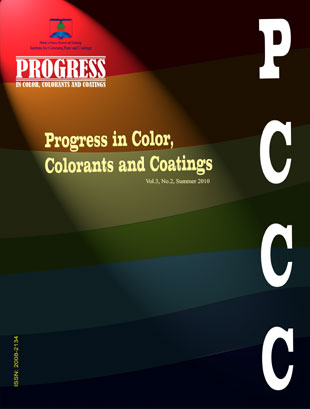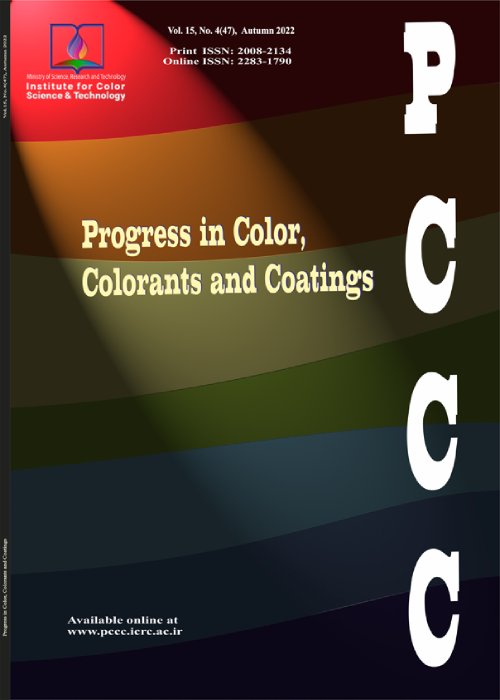فهرست مطالب

Progress in Color, Colorants and Coatings
Volume:3 Issue: 2, Summer 2010
- تاریخ انتشار: 1389/10/11
- تعداد عناوین: 7
-
-
Page 58A new catalytic kinetic spectrophotometric procedure for determination of trace quantities of zirconium was proposed. Janus Green was oxidized by potassium bromate and zirconium catalyst which then converted to a colorless product in acidic media. Reaction rate was monitored spectrophotometrically at 606 nm. It relies on the linear relationship between the absorbance difference (ΔAt) and Zr(IV) amounts in the range of 0.1-250 µg ml−1. Under optimum conditions, the sensitivity of the proposed method, i.e. the detection limit corresponding to 3 min is about 0.08 µg ml−1. The method is featured with good accuracy and reproducibility for zirconium(IV) determination in real samples. The method is simple, highly sensitive, selective and very stable. Prog. Color Colorants Coat. 3(2010), 58-65. © Institute for Color Science and Technology
-
Page 66The influence of polymeric dispersants containing different functional groups on TiO2 pigment particle suspension was investigated at pH 6.0 and 9.5, using rheology and particle size data. The dispersants chosen were polyacrylic acid and modified polyacrylamides including homo and copolymers modified with carboxylate and/or hydroxyl groups. The pigment suspension was strongly affected by both pH and dispersant functional groups. The pigment suspension exhibited a maximum yield stress and particle size at the pigment isoelectric point. The presence of carboxylate groups in both polyacrylic acid and anionic polyacrylamide copolymer altered the pigment dispersion behaviour, reducing the suspension yield stress and mean particle size. The polyacrylamide homo-polymer had negligible effect on the pigment dispersion properties at pH 9.5, while it caused pigment particle aggregation at pH 6.0. The hydroxyl-modified polyacrylamide had negligible effect on the pigment dispersion at pH 6.0, but decreased the yield stress and the mean particle size at pH 9.5. Prog.
-
Page 74The transition metal nitrides like titanium nitride exhibit very interesting color variation properties depending on the different plasma deposition conditions using cylindrical magnetron sputtering method. It is found in this deposition study that nitrogen partial pressure in the reactive gas discharge environment plays a significant role on the color variation of the film coatings on bell-metal which is commercially used for decorative as well as for a variety of industrial applications. UV-visible spectrophotometer spectra show that good film coatings has been deposited at argon:nitrogen gas partial pressure of 1:1. Magnetic field and the deposition time also play an important role in the color variation of the deposited titanium nitride film. Prog.
-
Page 82Nanocrystalline cadmium sulfide thin films as antireflection materials for solar cells have been prepared by a new chemical solution deposition route in an aqueous medium at 50 °C. as-deposited thin films were studied using X-ray diffraction (XRD), field emission scanning electron microscopy (FE-SEM), and optical absorption spectra. X-ray diffraction data indicated the formation of hexagonal nanocrystalline CdS thin films as the predominant phase. High film deposition rates, film uniformity and low percentage of reflection are achieved by proper optimization of CdS chemical bath. The as-deposited CdS films had more than 85% transmittance in the visible region. The direct band gap energy (Eg) of as-deposited films ranged from 3.85 to 3.90 eV depending on deposition time. This increase in Eg of deposited thin films can be assigned to the quantum size effect as expected from the nanocrystalline nature of the CdS thin films. Prog.
-
Page 92Electrochemical impedance spectroscopy and gravimetric methods were carried out to analyze water uptake of thin polyurethane films separately filled with either hydrophobic or hydrophilic nano-silica. Correspondingly the impedance spectra and gravimetric data were interpreted in terms of movement of water within the coating and/or to the coating/metal interface. Although the obtained results from gravimetric and EIS (Electrochemical Impedance Spectroscopy) methods followed generally a same trend, the water uptake values were not exactly identical. Type and content of nano silica had significant effects on the capability of water absorption of thin filled coatings. Indeed, it was found that rate and maximum level of moisture absorption of polyurethane coatings «strongly depended on the type and loads of nano-silica within the clear coat. To the other words, nano-particles with different nature affects on hydrophilicity and hydrophobicity of the organic matrix resulting in increasing or decreasing of water absorption of the resulted coating. Prog.
-
Page 102The efficiency of HZSM-5 Zeolite, tungestophosphoric acid (H3PW12O40) and tungestosililic acid (H4O40SiW12) were investigated in three-component, one-pot synthesis of coumarin dyes. These green and noncorrosive acids were highly efficient in synthesis of some coumarin dyes in excellent yield during concurrent formation of coumarin and benzimidazole or benzoxazole heterocycles (e.g. C. I. disperse yellow 232 as a commercial fluorescence dye was synthesized using tungestophosphoric acid in 45 minutes and %90 yield). Evaluations of the yields of products were studied in organic solvent (n-pentanol) and aqueous media and under solvent-free conditions considering the reaction times were studied as well. The results demonstrated that n-pentanol as an organic solvent was the best media for these preparations. Prog.
-
Page 110GdCaAl3O7:Eu red nano-phosphors were synthesized by solution combustion using urea as fuel. Fourier-transform infrared, X-ray diffraction, scanning electron microscope, transmission electron microscope and photoluminescence spectrophotometer were used to characterize the obtained samples. XRD patterns revealed that GdCaAl3O7:Eu pure phase was formed by combustion of metal nitrate solution in the presence of urea at pH= 1 without further calcination step. Further increase of pH values resulted in the formation of impure GdAlO3 phase. Moreover, for a constant pH, fuel to oxidizer variations did not affect the structure of the samples. Morphological studies revealed that flake like structure has changed to spongy like by increasing the pH value of metal nitrate solution from 1 to 4. Photoluminescence properties of obtained samples showed that at pH =1 emission ranging from 580-630 nm is observed. The characteristic peaks at 595 nm and 615 nm can be assigned to and transitions, respectively


